学Shiro完结版-5
第二十一章 授予身份及切换身份——《跟我学Shiro》
在一些场景中,比如某个领导因为一些原因不能进行登录网站进行一些操作,他想把他网站上的工作委托给他的秘书,但是他不想把帐号/密码告诉他秘书,只是想把工作委托给他;此时和我们可以使用Shiro的RunAs功能,即允许一个用户假装为另一个用户(如果他们允许)的身份进行访问。
本章代码基于《第十六章 综合实例》,请先了解相关数据模型及基本流程后再学习本章。
表及数据SQL
请运行shiro-example-chapter21/sql/ shiro-schema.sql 表结构
请运行shiro-example-chapter21/sql/ shiro-schema.sql 数据
实体
具体请参考com.github.zhangkaitao.shiro.chapter21包下的实体。
- public class UserRunAs implements Serializable {
- private Long fromUserId;//授予身份帐号
- private Long toUserId;//被授予身份帐号
- }
该实体定义了授予身份帐号(A)与被授予身份帐号(B)的关系,意思是B帐号将可以假装为A帐号的身份进行访问。
DAO
具体请参考com.github.zhangkaitao.shiro.chapter21.dao包下的DAO接口及实现。
Service
具体请参考com.github.zhangkaitao.shiro.chapter21.service包下的Service接口及实现。
- public interface UserRunAsService {
- public void grantRunAs(Long fromUserId, Long toUserId);
- public void revokeRunAs(Long fromUserId, Long toUserId);
- public boolean exists(Long fromUserId, Long toUserId);
- public List<Long> findFromUserIds(Long toUserId);
- public List<Long> findToUserIds(Long fromUserId);
- }
提供授予身份、回收身份、关系存在判断及查找API。
Web控制器RunAsController
该控制器完成:授予身份/回收身份/切换身份功能。
展示当前用户能切换到身份列表,及授予给其他人的身份列表:
- @RequestMapping
- public String runasList(@CurrentUser User loginUser, Model model) {
- model.addAttribute("fromUserIds",
- userRunAsService.findFromUserIds(loginUser.getId()));
- model.addAttribute("toUserIds", userRunAsService.findToUserIds(loginUser.getId()));
- List<User> allUsers = userService.findAll();
- allUsers.remove(loginUser);
- model.addAttribute("allUsers", allUsers);
- Subject subject = SecurityUtils.getSubject();
- model.addAttribute("isRunas", subject.isRunAs());
- if(subject.isRunAs()) {
- String previousUsername =
- (String)subject.getPreviousPrincipals().getPrimaryPrincipal();
- model.addAttribute("previousUsername", previousUsername);
- }
- return "runas";
- }
1、Subject.isRunAs():表示当前用户是否是RunAs用户,即已经切换身份了;
2、Subject.getPreviousPrincipals():得到切换身份之前的身份,一个用户可以切换很多次身份,之前的身份使用栈数据结构来存储;
授予身份
把当前用户身份授予给另一个用户,这样另一个用户可以切换身份到该用户。
- @RequestMapping("/grant/{toUserId}")
- public String grant(
- @CurrentUser User loginUser,
- @PathVariable("toUserId") Long toUserId,
- RedirectAttributes redirectAttributes) {
- if(loginUser.getId().equals(toUserId)) {
- redirectAttributes.addFlashAttribute("msg", "自己不能切换到自己的身份");
- return "redirect:/runas";
- }
- userRunAsService.grantRunAs(loginUser.getId(), toUserId);
- redirectAttributes.addFlashAttribute("msg", "操作成功");
- return "redirect:/runas";
- }
1、自己不能授予身份给自己;
2、调用UserRunAsService. grantRunAs把当前登录用户的身份授予给相应的用户;
回收身份
把授予给某个用户的身份回收回来。
- @RequestMapping("/revoke/{toUserId}")
- public String revoke(
- @CurrentUser User loginUser,
- @PathVariable("toUserId") Long toUserId,
- RedirectAttributes redirectAttributes) {
- userRunAsService.revokeRunAs(loginUser.getId(), toUserId);
- redirectAttributes.addFlashAttribute("msg", "操作成功");
- return "redirect:/runas";
- }
切换身份
- @RequestMapping("/switchTo/{switchToUserId}")
- public String switchTo(
- @CurrentUser User loginUser,
- @PathVariable("switchToUserId") Long switchToUserId,
- RedirectAttributes redirectAttributes) {
- Subject subject = SecurityUtils.getSubject();
- User switchToUser = userService.findOne(switchToUserId);
- if(loginUser.equals(switchToUser)) {
- redirectAttributes.addFlashAttribute("msg", "自己不能切换到自己的身份");
- return "redirect:/runas";
- }
- if(switchToUser == null || !userRunAsService.exists(switchToUserId, loginUser.getId())) {
- redirectAttributes.addFlashAttribute("msg", "对方没有授予您身份,不能切换");
- return "redirect:/runas";
- }
- subject.runAs(new SimplePrincipalCollection(switchToUser.getUsername(), ""));
- redirectAttributes.addFlashAttribute("msg", "操作成功");
- redirectAttributes.addFlashAttribute("needRefresh", "true");
- return "redirect:/runas";
- }
1、首先根据switchToUserId查找到要切换到的身份;
2、然后通过UserRunAsService. exists()判断当前登录用户是否可以切换到该身份;
3、通过Subject.runAs()切换到该身份;
切换到上一个身份
- @RequestMapping("/switchBack")
- public String switchBack(RedirectAttributes redirectAttributes) {
- Subject subject = SecurityUtils.getSubject();
- if(subject.isRunAs()) {
- subject.releaseRunAs();
- }
- redirectAttributes.addFlashAttribute("msg", "操作成功");
- redirectAttributes.addFlashAttribute("needRefresh", "true");
- return "redirect:/runas";
- }
1、通过Subject.releaseRunAs()切换会上一个身份;
此处注意的是我们可以切换多次身份,如A切换到B,然后再切换到C;那么需要调用两次Subject. releaseRunAs()才能切换会A;即内部使用栈数据结构存储着切换过的用户;Subject. getPreviousPrincipals()得到上一次切换到的身份,比如当前是C;那么调用该API将得到B的身份。
其他代码和配置和《第十六章 综合实例》一样,请参考该章。
测试
1、首先访问http://localhost:8080/chapter21/,输入admin/123456进行登录;会看到如下界面:

2、点击切换身份按钮,跳到如下界面:

在该界面可以授权身份给其他人(点击授权身份可以把自己的身份授权给其他人/点击回收身份可以把之前授予的身份撤回)、或切换到其他身份(即假装为其他身份运行);
3、点击切换到该身份按钮,切换到相应的身份运行,如:
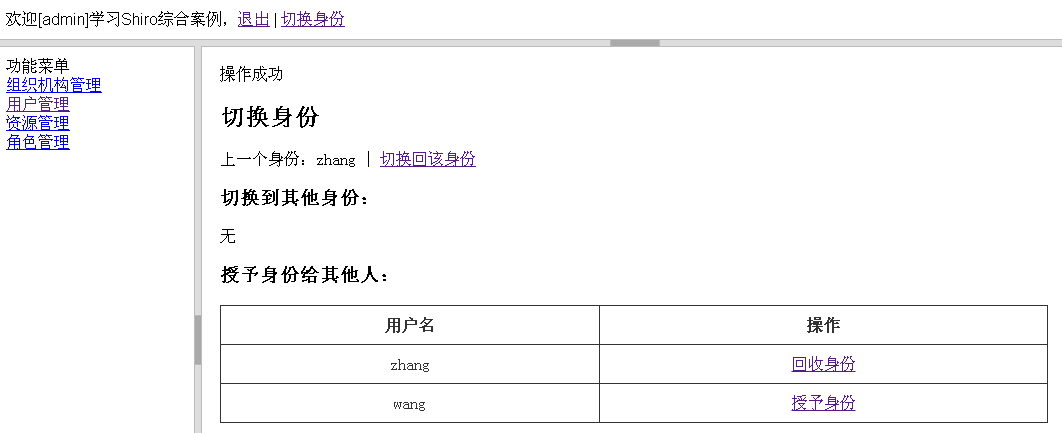
此时zhang用户切换到admin身份;如果点击切换回该身份,会把当前身份切换会zhang。
第二十二章 集成验证码——《跟我学Shiro》
在做用户登录功能时,很多时候都需要验证码支持,验证码的目的是为了防止机器人模拟真实用户登录而恶意访问,如暴力破解用户密码/恶意评论等。目前也有一些验证码比较简单,通过一些OCR工具就可以解析出来;另外还有一些验证码比较复杂(一般通过如扭曲、加线条/噪点等干扰)防止OCR工具识别;但是在中国就是人多,机器干不了的可以交给人来完成,所以在中国就有很多打码平台,人工识别验证码;因此即使比较复杂的如填字、算数等类型的验证码还是能识别的。所以验证码也不是绝对可靠的,目前比较可靠还是手机验证码,但是对于用户来说相对于验证码还是比较麻烦的。
对于验证码图片的生成,可以自己通过如Java提供的图像API自己去生成,也可以借助如JCaptcha这种开源Java类库生成验证码图片;JCaptcha提供了常见的如扭曲、加噪点等干扰支持。本章代码基于《第十六章 综合实例》。
一、添加JCaptcha依赖
- <dependency>
- <groupId>com.octo.captcha</groupId>
- <artifactId>jcaptcha</artifactId>
- <version>2.0-alpha-1</version>
- </dependency>
- <dependency>
- <groupId>com.octo.captcha</groupId>
- <artifactId>jcaptcha-integration-simple-servlet</artifactId>
- <version>2.0-alpha-1</version>
- <exclusions>
- <exclusion>
- <artifactId>servlet-api</artifactId>
- <groupId>javax.servlet</groupId>
- </exclusion>
- </exclusions>
- </dependency>
com.octo.captcha . jcaptcha 提供了jcaptcha 核心;而jcaptcha-integration-simple-servlet提供了与Servlet集成。
二、GMailEngine
来自https://code.google.com/p/musicvalley/source/browse/trunk/musicvalley/doc/springSecurity/springSecurityIII/src/main/java/com/spring/security/jcaptcha/GMailEngine.java?spec=svn447&r=447(目前无法访问了),仿照JCaptcha2.0编写类似GMail验证码的样式;具体请参考com.github.zhangkaitao.shiro.chapter22.jcaptcha.GMailEngine。
三、MyManageableImageCaptchaService
提供了判断仓库中是否有相应的验证码存在。
- public class MyManageableImageCaptchaService extends
- DefaultManageableImageCaptchaService {
- public MyManageableImageCaptchaService(
- com.octo.captcha.service.captchastore.CaptchaStore captchaStore,
- com.octo.captcha.engine.CaptchaEngine captchaEngine,
- int minGuarantedStorageDelayInSeconds,
- int maxCaptchaStoreSize,
- int captchaStoreLoadBeforeGarbageCollection) {
- super(captchaStore, captchaEngine, minGuarantedStorageDelayInSeconds,
- maxCaptchaStoreSize, captchaStoreLoadBeforeGarbageCollection);
- }
- public boolean hasCapcha(String id, String userCaptchaResponse) {
- return store.getCaptcha(id).validateResponse(userCaptchaResponse);
- }
- }
四、JCaptcha工具类
提供相应的API来验证当前请求输入的验证码是否正确。
- public class JCaptcha {
- public static final MyManageableImageCaptchaService captchaService
- = new MyManageableImageCaptchaService(new FastHashMapCaptchaStore(),
- new GMailEngine(), 180, 100000, 75000);
- public static boolean validateResponse(
- HttpServletRequest request, String userCaptchaResponse) {
- if (request.getSession(false) == null) return false;
- boolean validated = false;
- try {
- String id = request.getSession().getId();
- validated =
- captchaService.validateResponseForID(id, userCaptchaResponse)
- .booleanValue();
- } catch (CaptchaServiceException e) {
- e.printStackTrace();
- }
- return validated;
- }
- public static boolean hasCaptcha(
- HttpServletRequest request, String userCaptchaResponse) {
- if (request.getSession(false) == null) return false;
- boolean validated = false;
- try {
- String id = request.getSession().getId();
- validated = captchaService.hasCapcha(id, userCaptchaResponse);
- } catch (CaptchaServiceException e) {
- e.printStackTrace();
- }
- return validated;
- }
- }
validateResponse():验证当前请求输入的验证码否正确;并从CaptchaService中删除已经生成的验证码;
hasCaptcha():验证当前请求输入的验证码是否正确;但不从CaptchaService中删除已经生成的验证码(比如Ajax验证时可以使用,防止多次生成验证码);
五、JCaptchaFilter
用于生成验证码图片的过滤器。
- public class JCaptchaFilter extends OncePerRequestFilter {
- protected void doFilterInternal(HttpServletRequest request, HttpServletResponse response, FilterChain filterChain) throws ServletException, IOException {
- response.setDateHeader("Expires", 0L);
- response.setHeader("Cache-Control", "no-store, no-cache, must-revalidate");
- response.addHeader("Cache-Control", "post-check=0, pre-check=0");
- response.setHeader("Pragma", "no-cache");
- response.setContentType("image/jpeg");
- String id = request.getRequestedSessionId();
- BufferedImage bi = JCaptcha.captchaService.getImageChallengeForID(id);
- ServletOutputStream out = response.getOutputStream();
- ImageIO.write(bi, "jpg", out);
- try {
- out.flush();
- } finally {
- out.close();
- }
- }
- }
CaptchaService使用当前会话ID当作key获取相应的验证码图片;另外需要设置响应内容不进行浏览器端缓存。
- <!-- 验证码过滤器需要放到Shiro之后 因为Shiro将包装HttpSession 如果不,可能造成两次的sesison id 不一样 -->
- <filter>
- <filter-name>JCaptchaFilter</filter-name>
- <filter-class>
- com.github.zhangkaitao.shiro.chapter22.jcaptcha.JCaptchaFilter
- </filter-class>
- </filter>
- <filter-mapping>
- <filter-name>JCaptchaFilter</filter-name>
- <url-pattern>/jcaptcha.jpg</url-pattern>
- </filter-mapping>
这样就可以在页面使用/jcaptcha.jpg地址显示验证码图片。
六、JCaptchaValidateFilter
用于验证码验证的Shiro过滤器。
- public class JCaptchaValidateFilter extends AccessControlFilter {
- private boolean jcaptchaEbabled = true;//是否开启验证码支持
- private String jcaptchaParam = "jcaptchaCode";//前台提交的验证码参数名
- private String failureKeyAttribute = "shiroLoginFailure"; //验证失败后存储到的属性名
- public void setJcaptchaEbabled(boolean jcaptchaEbabled) {
- this.jcaptchaEbabled = jcaptchaEbabled;
- }
- public void setJcaptchaParam(String jcaptchaParam) {
- this.jcaptchaParam = jcaptchaParam;
- }
- public void setFailureKeyAttribute(String failureKeyAttribute) {
- this.failureKeyAttribute = failureKeyAttribute;
- }
- protected boolean isAccessAllowed(ServletRequest request, ServletResponse response, Object mappedValue) throws Exception {
- //1、设置验证码是否开启属性,页面可以根据该属性来决定是否显示验证码
- request.setAttribute("jcaptchaEbabled", jcaptchaEbabled);
- HttpServletRequest httpServletRequest = WebUtils.toHttp(request);
- //2、判断验证码是否禁用 或不是表单提交(允许访问)
- if (jcaptchaEbabled == false || !"post".equalsIgnoreCase(httpServletRequest.getMethod())) {
- return true;
- }
- //3、此时是表单提交,验证验证码是否正确
- return JCaptcha.validateResponse(httpServletRequest, httpServletRequest.getParameter(jcaptchaParam));
- }
- protected boolean onAccessDenied(ServletRequest request, ServletResponse response) throws Exception {
- //如果验证码失败了,存储失败key属性
- request.setAttribute(failureKeyAttribute, "jCaptcha.error");
- return true;
- }
- }
七、MyFormAuthenticationFilter
用于验证码验证的Shiro拦截器在用于身份认证的拦截器之前运行;但是如果验证码验证拦截器失败了,就不需要进行身份认证拦截器流程了;所以需要修改下如FormAuthenticationFilter身份认证拦截器,当验证码验证失败时不再走身份认证拦截器。
- public class MyFormAuthenticationFilter extends FormAuthenticationFilter {
- protected boolean onAccessDenied(ServletRequest request, ServletResponse response, Object mappedValue) throws Exception {
- if(request.getAttribute(getFailureKeyAttribute()) != null) {
- return true;
- }
- return super.onAccessDenied(request, response, mappedValue);
- }
- }
即如果之前已经错了,那直接跳过即可。
八、spring-config-shiro.xml
- <!-- 基于Form表单的身份验证过滤器 -->
- <bean id="authcFilter"
- class="com.github.zhangkaitao.shiro.chapter22.jcaptcha.MyFormAuthenticationFilter">
- <property name="usernameParam" value="username"/>
- <property name="passwordParam" value="password"/>
- <property name="rememberMeParam" value="rememberMe"/>
- <property name="failureKeyAttribute" value="shiroLoginFailure"/>
- </bean>
- <bean id="jCaptchaValidateFilter"
- class="com.github.zhangkaitao.shiro.chapter22.jcaptcha.JCaptchaValidateFilter">
- <property name="jcaptchaEbabled" value="true"/>
- <property name="jcaptchaParam" value="jcaptchaCode"/>
- <property name="failureKeyAttribute" value="shiroLoginFailure"/>
- </bean>
- <!-- Shiro的Web过滤器 -->
- <bean id="shiroFilter" class="org.apache.shiro.spring.web.ShiroFilterFactoryBean">
- <property name="securityManager" ref="securityManager"/>
- <property name="loginUrl" value="/login"/>
- <property name="filters">
- <util:map>
- <entry key="authc" value-ref="authcFilter"/>
- <entry key="sysUser" value-ref="sysUserFilter"/>
- <entry key="jCaptchaValidate" value-ref="jCaptchaValidateFilter"/>
- </util:map>
- </property>
- <property name="filterChainDefinitions">
- <value>
- /static/** = anon
- /jcaptcha* = anon
- /login = jCaptchaValidate,authc
- /logout = logout
- /authenticated = authc
- /** = user,sysUser
- </value>
- </property>
- </bean>
九、login.jsp登录页面
- <c:if test="${jcaptchaEbabled}">
- 验证码:
- <input type="text" name="jcaptchaCode">
- <img class="jcaptcha-btn jcaptcha-img"
- src="${pageContext.request.contextPath}/jcaptcha.jpg" title="点击更换验证码">
- <a class="jcaptcha-btn" href="javascript:;">换一张</a>
- <br/>
- </c:if>
根据jcaptchaEbabled来显示验证码图片。
十、测试
输入http://localhost:8080/chapter22将重定向到登录页面;输入正确的用户名/密码/验证码即可成功登录,如果输入错误的验证码,将显示验证码错误页面:

第二十三章 多项目集中权限管理及分布式会话——《跟我学Shiro》
在做一些企业内部项目时或一些互联网后台时;可能会涉及到集中权限管理,统一进行多项目的权限管理;另外也需要统一的会话管理,即实现单点身份认证和授权控制。
学习本章之前,请务必先学习《第十章 会话管理》和《第十六章 综合实例》,本章代码都是基于这两章的代码基础上完成的。
本章示例是同域名的场景下完成的,如果跨域请参考《第十五章 单点登录》和《第十七章 OAuth2集成》了解使用CAS或OAuth2实现跨域的身份验证和授权。另外比如客户端/服务器端的安全校验可参考《第二十章 无状态Web应用集成》。
部署架构
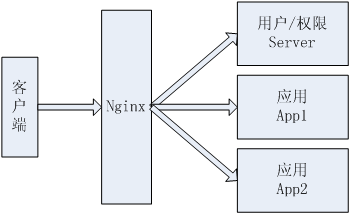
1、有三个应用:用于用户/权限控制的Server(端口:8080);两个应用App1(端口9080)和App2(端口10080);
2、使用Nginx反向代理这三个应用,nginx.conf的server配置部分如下:
- server {
- listen 80;
- server_name localhost;
- charset utf-8;
- location ~ ^/(chapter23-server)/ {
- proxy_pass http://127.0.0.1:8080;
- index /;
- proxy_set_header Host $host;
- }
- location ~ ^/(chapter23-app1)/ {
- proxy_pass http://127.0.0.1:9080;
- index /;
- proxy_set_header Host $host;
- }
- location ~ ^/(chapter23-app2)/ {
- proxy_pass http://127.0.0.1:10080;
- index /;
- proxy_set_header Host $host;
- }
- }
如访问http://localhost/chapter23-server会自动转发到http://localhost:8080/chapter23-server;
访问http://localhost/chapter23-app1会自动转发到http://localhost:9080/chapter23-app1;访问http://localhost/chapter23-app3会自动转发到http://localhost:10080/chapter23-app3;
Nginx的安装及使用请自行搜索学习,本文不再阐述。
项目架构
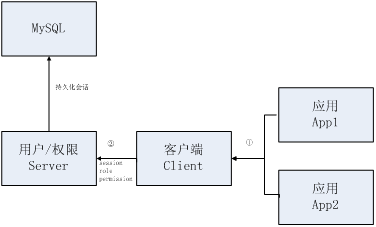
1、首先通过用户/权限Server维护用户、应用、权限信息;数据都持久化到MySQL数据库中;
2、应用App1/应用App2使用客户端Client远程调用用户/权限Server获取会话及权限信息。
此处使用Mysql存储会话,而不是使用如Memcached/Redis之类的,主要目的是降低学习成本;如果换成如Redis也不会很难;如:
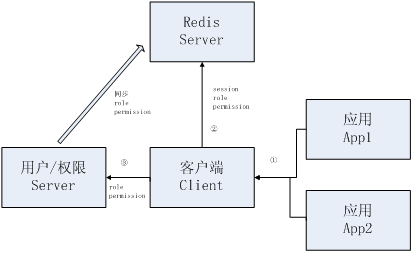
使用如Redis还一个好处就是无需在用户/权限Server中开会话过期调度器,可以借助Redis自身的过期策略来完成。
模块关系依赖
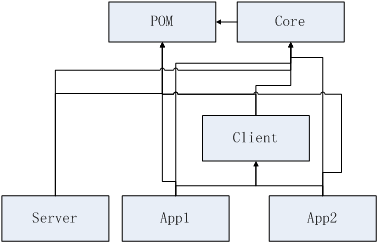
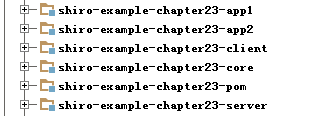
1、shiro-example-chapter23-pom模块:提供了其他所有模块的依赖;这样其他模块直接继承它即可,简化依赖配置,如shiro-example-chapter23-server:
- <parent>
- <artifactId>shiro-example-chapter23-pom</artifactId>
- <groupId>com.github.zhangkaitao</groupId>
- <version>1.0-SNAPSHOT</version>
- </parent>
2、shiro-example-chapter23-core模块:提供给shiro-example-chapter23-server、shiro-example-chapter23-client、shiro-example-chapter23-app*模块的核心依赖,比如远程调用接口等;
3、shiro-example-chapter23-server模块:提供了用户、应用、权限管理功能;
4、shiro-example-chapter23-client模块:提供给应用模块获取会话及应用对应的权限信息;
5、shiro-example-chapter23-app*模块:各个子应用,如一些内部管理系统应用;其登录都跳到shiro-example-chapter23-server登录;另外权限都从shiro-example-chapter23-server获取(如通过远程调用)。
shiro-example-chapter23-pom模块
其pom.xml的packaging类型为pom,并且在该pom中加入其他模块需要的依赖,然后其他模块只需要把该模块设置为parent即可自动继承这些依赖,如shiro-example-chapter23-server模块:
- <parent>
- <artifactId>shiro-example-chapter23-pom</artifactId>
- <groupId>com.github.zhangkaitao</groupId>
- <version>1.0-SNAPSHOT</version>
- </parent>
简化其他模块的依赖配置等。
shiro-example-chapter23-core模块
提供了其他模块共有的依赖,如远程调用接口:
- public interface RemoteServiceInterface {
- public Session getSession(String appKey, Serializable sessionId);
- Serializable createSession(Session session);
- public void updateSession(String appKey, Session session);
- public void deleteSession(String appKey, Session session);
- public PermissionContext getPermissions(String appKey, String username);
- }
提供了会话的CRUD,及根据应用key和用户名获取权限上下文(包括角色和权限字符串);shiro-example-chapter23-server模块服务端实现;shiro-example-chapter23-client模块客户端调用。
另外提供了com.github.zhangkaitao.shiro.chapter23.core.ClientSavedRequest,其扩展了org.apache.shiro.web.util.SavedRequest;用于shiro-example-chapter23-app*模块当访问一些需要登录的请求时,自动把请求保存下来,然后重定向到shiro-example-chapter23-server模块登录;登录成功后再重定向回来;因为SavedRequest不保存URL中的schema://domain:port部分;所以才需要扩展SavedRequest;使得ClientSavedRequest能保存schema://domain:port;这样才能从一个应用重定向另一个(要不然只能在一个应用内重定向):
- public String getRequestUrl() {
- String requestURI = getRequestURI();
- if(backUrl != null) {//1
- if(backUrl.toLowerCase().startsWith("http://") || backUrl.toLowerCase().startsWith("https://")) {
- return backUrl;
- } else if(!backUrl.startsWith(contextPath)) {//2
- requestURI = contextPath + backUrl;
- } else {//3
- requestURI = backUrl;
- }
- }
- StringBuilder requestUrl = new StringBuilder(scheme);//4
- requestUrl.append("://");
- requestUrl.append(domain);//5
- //6
- if("http".equalsIgnoreCase(scheme) && port != 80) {
- requestUrl.append(":").append(String.valueOf(port));
- } else if("https".equalsIgnoreCase(scheme) && port != 443) {
- requestUrl.append(":").append(String.valueOf(port));
- }
- //7
- requestUrl.append(requestURI);
- //8
- if (backUrl == null && getQueryString() != null) {
- requestUrl.append("?").append(getQueryString());
- }
- return requestUrl.toString();
- }
1、如果从外部传入了successUrl(登录成功之后重定向的地址),且以http://或https://开头那么直接返回(相应的拦截器直接重定向到它即可);
2、如果successUrl有值但没有上下文,拼上上下文;
3、否则,如果successUrl有值,直接赋值给requestUrl即可;否则,如果successUrl没值,那么requestUrl就是当前请求的地址;
5、拼上url前边的schema,如http或https;
6、拼上域名;
7、拼上重定向到的地址(带上下文);
8、如果successUrl没值,且有查询参数,拼上;
9返回该地址,相应的拦截器直接重定向到它即可。
shiro-example-chapter23-server模块
简单的实体关系图
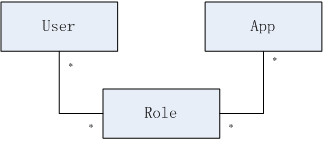
简单数据字典
用户(sys_user)
|
名称 |
类型 |
长度 |
描述 |
|
id |
bigint |
|
编号 主键 |
|
username |
varchar |
100 |
用户名 |
|
password |
varchar |
100 |
密码 |
|
salt |
varchar |
50 |
盐 |
|
locked |
bool |
|
账户是否锁定 |
应用(sys_app)
|
名称 |
类型 |
长度 |
描述 |
|
id |
bigint |
|
编号 主键 |
|
name |
varchar |
100 |
应用名称 |
|
app_key |
varchar |
100 |
应用key(唯一) |
|
app_secret |
varchar |
100 |
应用安全码 |
|
available |
bool |
|
是否锁定 |
授权(sys_authorization)
|
名称 |
类型 |
长度 |
描述 |
|
id |
bigint |
|
编号 主键 |
|
user_id |
bigint |
|
所属用户 |
|
app_id |
bigint |
|
所属应用 |
|
role_ids |
varchar |
100 |
角色列表 |
用户:比《第十六章 综合实例》少了role_ids,因为本章是多项目集中权限管理;所以授权时需要指定相应的应用;而不是直接给用户授权;所以不能在用户中出现role_ids了;
应用:所有集中权限的应用;在此处需要指定应用key(app_key)和应用安全码(app_secret),app在访问server时需要指定自己的app_key和用户名来获取该app对应用户权限信息;另外app_secret可以认为app的密码,比如需要安全访问时可以考虑使用它,可参考《第二十章 无状态Web应用集成》。另外available属性表示该应用当前是否开启;如果false表示该应用当前不可用,即不能获取到相应的权限信息。
授权:给指定的用户在指定的app下授权,即角色是与用户和app存在关联关系。
因为本章使用了《第十六章 综合实例》代码,所以还有其他相应的表结构(本章未使用到)。
表/数据SQL
具体请参考
sql/ shiro-schema.sql (表结构)
sql/ shiro-data.sql (初始数据)
实体
具体请参考com.github.zhangkaitao.shiro.chapter23.entity包下的实体,此处就不列举了。
DAO
具体请参考com.github.zhangkaitao.shiro.chapter23.dao包下的DAO接口及实现。
Service
具体请参考com.github.zhangkaitao.shiro.chapter23.service包下的Service接口及实现。以下是出了基本CRUD之外的关键接口:
- public interface AppService {
- public Long findAppIdByAppKey(String appKey);// 根据appKey查找AppId
- }
- public interface AuthorizationService {
- //根据AppKey和用户名查找其角色
- public Set<String> findRoles(String appKey, String username);
- //根据AppKey和用户名查找权限字符串
- public Set<String> findPermissions(String appKey, String username);
- }
根据AppKey和用户名查找用户在指定应用中对于的角色和权限字符串。
UserRealm
- protected AuthorizationInfo doGetAuthorizationInfo(PrincipalCollection principals) {
- String username = (String)principals.getPrimaryPrincipal();
- SimpleAuthorizationInfo authorizationInfo = new SimpleAuthorizationInfo();
- authorizationInfo.setRoles(
- authorizationService.findRoles(Constants.SERVER_APP_KEY, username));
- authorizationInfo.setStringPermissions(
- authorizationService.findPermissions(Constants.SERVER_APP_KEY, username));
- return authorizationInfo;
- }
此处需要调用AuthorizationService的findRoles/findPermissions方法传入AppKey和用户名来获取用户的角色和权限字符串集合。其他的和《第十六章 综合实例》代码一样。
ServerFormAuthenticationFilter
- public class ServerFormAuthenticationFilter extends FormAuthenticationFilter {
- protected void issueSuccessRedirect(ServletRequest request, ServletResponse response) throws Exception {
- String fallbackUrl = (String) getSubject(request, response)
- .getSession().getAttribute("authc.fallbackUrl");
- if(StringUtils.isEmpty(fallbackUrl)) {
- fallbackUrl = getSuccessUrl();
- }
- WebUtils.redirectToSavedRequest(request, response, fallbackUrl);
- }
- }
因为是多项目登录,比如如果是从其他应用中重定向过来的,首先检查Session中是否有“authc.fallbackUrl”属性,如果有就认为它是默认的重定向地址;否则使用Server自己的successUrl作为登录成功后重定向到的地址。
MySqlSessionDAO
将会话持久化到Mysql数据库;此处大家可以将其实现为如存储到Redis/Memcached等,实现策略请参考《第十章 会话管理》中的会话存储/持久化章节的MySessionDAO,完全一样。
MySqlSessionValidationScheduler
和《第十章 会话管理》中的会话验证章节部分中的MySessionValidationScheduler完全一样。如果使用如Redis之类的有自动过期策略的DB,完全可以不用实现SessionValidationScheduler,直接借助于这些DB的过期策略即可。
RemoteService
- public class RemoteService implements RemoteServiceInterface {
- @Autowired private AuthorizationService authorizationService;
- @Autowired private SessionDAO sessionDAO;
- public Session getSession(String appKey, Serializable sessionId) {
- return sessionDAO.readSession(sessionId);
- }
- public Serializable createSession(Session session) {
- return sessionDAO.create(session);
- }
- public void updateSession(String appKey, Session session) {
- sessionDAO.update(session);
- }
- public void deleteSession(String appKey, Session session) {
- sessionDAO.delete(session);
- }
- public PermissionContext getPermissions(String appKey, String username) {
- PermissionContext permissionContext = new PermissionContext();
- permissionContext.setRoles(authorizationService.findRoles(appKey, username));
- permissionContext.setPermissions(authorizationService.findPermissions(appKey, username));
- return permissionContext;
- }
- }
将会使用HTTP调用器暴露为远程服务,这样其他应用就可以使用相应的客户端调用这些接口进行Session的集中维护及根据AppKey和用户名获取角色/权限字符串集合。此处没有实现安全校验功能,如果是局域网内使用可以通过限定IP完成;否则需要使用如《第二十章 无状态Web应用集成》中的技术完成安全校验。
然后在spring-mvc-remote-service.xml配置文件把服务暴露出去:
- <bean id="remoteService"
- class="com.github.zhangkaitao.shiro.chapter23.remote.RemoteService"/>
- <bean name="/remoteService"
- class="org.springframework.remoting.httpinvoker.HttpInvokerServiceExporter">
- <property name="service" ref="remoteService"/>
- <property name="serviceInterface"
- value="com.github.zhangkaitao.shiro.chapter23.remote.RemoteServiceInterface"/>
- </bean>
Shiro配置文件spring-config-shiro.xml
和《第十六章 综合实例》配置类似,但是需要在shiroFilter中的filterChainDefinitions中添加如下配置,即远程调用不需要身份认证:
- /remoteService = anon
对于userRealm的缓存配置直接禁用;因为如果开启,修改了用户权限不会自动同步到缓存;另外请参考《第十一章 缓存机制》进行缓存的正确配置。
服务器端数据维护
1、首先开启ngnix反向代理;然后就可以直接访问http://localhost/chapter23-server/;
2、输入默认的用户名密码:admin/123456登录
3、应用管理,进行应用的CRUD,主要维护应用KEY(必须唯一)及应用安全码;客户端就可以使用应用KEY获取用户对应应用的权限了。
4、授权管理,维护在哪个应用中用户的角色列表。这样客户端就可以根据应用KEY及用户名获取到对应的角色/权限字符串列表了。
shiro-example-chapter23-client模块
Client模块提供给其他应用模块依赖,这样其他应用模块只需要依赖Client模块,然后再在相应的配置文件中配置如登录地址、远程接口地址、拦截器链等等即可,简化其他应用模块的配置。
配置远程服务spring-client-remote-service.xml
- <bean id="remoteService"
- class="org.springframework.remoting.httpinvoker.HttpInvokerProxyFactoryBean">
- <property name="serviceUrl" value="${client.remote.service.url}"/>
- <property name="serviceInterface"
- value="com.github.zhangkaitao.shiro.chapter23.remote.RemoteServiceInterface"/>
- </bean>
client.remote.service.url是远程服务暴露的地址;通过相应的properties配置文件配置,后续介绍。然后就可以通过remoteService获取会话及角色/权限字符串集合了。
ClientRealm
- public class ClientRealm extends AuthorizingRealm {
- private RemoteServiceInterface remoteService;
- private String appKey;
- public void setRemoteService(RemoteServiceInterface remoteService) {
- this.remoteService = remoteService;
- }
- public void setAppKey(String appKey) {
- this.appKey = appKey;
- }
- protected AuthorizationInfo doGetAuthorizationInfo(PrincipalCollection principals) {
- String username = (String) principals.getPrimaryPrincipal();
- SimpleAuthorizationInfo authorizationInfo = new SimpleAuthorizationInfo();
- PermissionContext context = remoteService.getPermissions(appKey, username);
- authorizationInfo.setRoles(context.getRoles());
- authorizationInfo.setStringPermissions(context.getPermissions());
- return authorizationInfo;
- }
- protected AuthenticationInfo doGetAuthenticationInfo(AuthenticationToken token) throws AuthenticationException {
- //永远不会被调用
- throw new UnsupportedOperationException("永远不会被调用");
- }
- }
ClientRealm提供身份认证信息和授权信息,此处因为是其他应用依赖客户端,而这些应用不会实现身份认证,所以doGetAuthenticationInfo获取身份认证信息直接无须实现。另外获取授权信息,是通过远程暴露的服务RemoteServiceInterface获取,提供appKey和用户名获取即可。
ClientSessionDAO
- public class ClientSessionDAO extends CachingSessionDAO {
- private RemoteServiceInterface remoteService;
- private String appKey;
- public void setRemoteService(RemoteServiceInterface remoteService) {
- this.remoteService = remoteService;
- }
- public void setAppKey(String appKey) {
- this.appKey = appKey;
- }
- protected void doDelete(Session session) {
- remoteService.deleteSession(appKey, session);
- }
- protected void doUpdate(Session session) {
- remoteService.updateSession(appKey, session);
- }
- protected Serializable doCreate(Session session) {
- Serializable sessionId = remoteService.createSession(session);
- assignSessionId(session, sessionId);
- return sessionId;
- }
- protected Session doReadSession(Serializable sessionId) {
- return remoteService.getSession(appKey, sessionId);
- }
- }
Session的维护通过远程暴露接口实现,即本地不维护会话。
ClientAuthenticationFilter
- public class ClientAuthenticationFilter extends AuthenticationFilter {
- protected boolean isAccessAllowed(ServletRequest request, ServletResponse response, Object mappedValue) {
- Subject subject = getSubject(request, response);
- return subject.isAuthenticated();
- }
- protected boolean onAccessDenied(ServletRequest request, ServletResponse response) throws Exception {
- String backUrl = request.getParameter("backUrl");
- saveRequest(request, backUrl, getDefaultBackUrl(WebUtils.toHttp(request)));
- return false;
- }
- protected void saveRequest(ServletRequest request, String backUrl, String fallbackUrl) {
- Subject subject = SecurityUtils.getSubject();
- Session session = subject.getSession();
- HttpServletRequest httpRequest = WebUtils.toHttp(request);
- session.setAttribute("authc.fallbackUrl", fallbackUrl);
- SavedRequest savedRequest = new ClientSavedRequest(httpRequest, backUrl);
- session.setAttribute(WebUtils.SAVED_REQUEST_KEY, savedRequest);
- }
- private String getDefaultBackUrl(HttpServletRequest request) {
- String scheme = request.getScheme();
- String domain = request.getServerName();
- int port = request.getServerPort();
- String contextPath = request.getContextPath();
- StringBuilder backUrl = new StringBuilder(scheme);
- backUrl.append("://");
- backUrl.append(domain);
- if("http".equalsIgnoreCase(scheme) && port != 80) {
- backUrl.append(":").append(String.valueOf(port));
- } else if("https".equalsIgnoreCase(scheme) && port != 443) {
- backUrl.append(":").append(String.valueOf(port));
- }
- backUrl.append(contextPath);
- backUrl.append(getSuccessUrl());
- return backUrl.toString();
- }
- }
ClientAuthenticationFilter是用于实现身份认证的拦截器(authc),当用户没有身份认证时;
1、首先得到请求参数backUrl,即登录成功重定向到的地址;
2、然后保存保存请求到会话,并重定向到登录地址(server模块);
3、登录成功后,返回地址按照如下顺序获取:backUrl、保存的当前请求地址、defaultBackUrl(即设置的successUrl);
ClientShiroFilterFactoryBean
- public class ClientShiroFilterFactoryBean extends ShiroFilterFactoryBean implements ApplicationContextAware {
- private ApplicationContext applicationContext;
- public void setApplicationContext(ApplicationContext applicationContext) {
- this.applicationContext = applicationContext;
- }
- public void setFiltersStr(String filters) {
- if(StringUtils.isEmpty(filters)) {
- return;
- }
- String[] filterArray = filters.split(";");
- for(String filter : filterArray) {
- String[] o = filter.split("=");
- getFilters().put(o[0], (Filter)applicationContext.getBean(o[1]));
- }
- }
- public void setFilterChainDefinitionsStr(String filterChainDefinitions) {
- if(StringUtils.isEmpty(filterChainDefinitions)) {
- return;
- }
- String[] chainDefinitionsArray = filterChainDefinitions.split(";");
- for(String filter : chainDefinitionsArray) {
- String[] o = filter.split("=");
- getFilterChainDefinitionMap().put(o[0], o[1]);
- }
- }
- }
1、setFiltersStr:设置拦截器,设置格式如“filterName=filterBeanName; filterName=filterBeanName”;多个之间分号分隔;然后通过applicationContext获取filterBeanName对应的Bean注册到拦截器Map中;
2、setFilterChainDefinitionsStr:设置拦截器链,设置格式如“url=filterName1[config],filterName2; url=filterName1[config],filterName2”;多个之间分号分隔;
Shiro客户端配置spring-client.xml
提供了各应用通用的Shiro客户端配置;这样应用只需要导入相应该配置即可完成Shiro的配置,简化了整个配置过程。
- <context:property-placeholder location=
- "classpath:client/shiro-client-default.properties,classpath:client/shiro-client.properties"/>
提供给客户端配置的properties属性文件,client/shiro-client-default.properties是客户端提供的默认的配置;classpath:client/shiro-client.properties是用于覆盖客户端默认配置,各应用应该提供该配置文件,然后提供各应用个性配置。
- <bean id="remoteRealm" class="com.github.zhangkaitao.shiro.chapter23.client.ClientRealm">
- <property name="cachingEnabled" value="false"/>
- <property name="appKey" value="${client.app.key}"/>
- <property name="remoteService" ref="remoteService"/>
- </bean>
appKey:使用${client.app.key}占位符替换,即需要在之前的properties文件中配置。
- <bean id="sessionIdCookie" class="org.apache.shiro.web.servlet.SimpleCookie">
- <constructor-arg value="${client.session.id}"/>
- <property name="httpOnly" value="true"/>
- <property name="maxAge" value="-1"/>
- <property name="domain" value="${client.cookie.domain}"/>
- <property name="path" value="${client.cookie.path}"/>
- </bean>
Session Id Cookie,cookie名字、域名、路径等都是通过配置文件配置。
- <bean id="sessionDAO"
- class="com.github.zhangkaitao.shiro.chapter23.client.ClientSessionDAO">
- <property name="sessionIdGenerator" ref="sessionIdGenerator"/>
- <property name="appKey" value="${client.app.key}"/>
- <property name="remoteService" ref="remoteService"/>
- </bean>
SessionDAO的appKey,也是通过${ client.app.key }占位符替换,需要在配置文件配置。
- <bean id="sessionManager"
- class="org.apache.shiro.web.session.mgt.DefaultWebSessionManager">
- <property name="sessionValidationSchedulerEnabled" value="false"/>//省略其他
- </bean>
其他应用无须进行会话过期调度,所以sessionValidationSchedulerEnabled=false。
- <bean id="clientAuthenticationFilter"
- class="com.github.zhangkaitao.shiro.chapter23.client.ClientAuthenticationFilter"/>
应用的身份认证使用ClientAuthenticationFilter,即如果没有身份认证,则会重定向到Server模块完成身份认证,身份认证成功后再重定向回来。
- <bean id="shiroFilter"
- class="com.github.zhangkaitao.shiro.chapter23.client.ClientShiroFilterFactoryBean">
- <property name="securityManager" ref="securityManager"/>
- <property name="loginUrl" value="${client.login.url}"/>
- <property name="successUrl" value="${client.success.url}"/>
- <property name="unauthorizedUrl" value="${client.unauthorized.url}"/>
- <property name="filters">
- <util:map>
- <entry key="authc" value-ref="clientAuthenticationFilter"/>
- </util:map>
- </property>
- <property name="filtersStr" value="${client.filters}"/>
- <property name="filterChainDefinitionsStr" value="${client.filter.chain.definitions}"/>
- </bean>
ShiroFilter使用我们自定义的ClientShiroFilterFactoryBean,然后loginUrl(登录地址)、successUrl(登录成功后默认的重定向地址)、unauthorizedUrl(未授权重定向到的地址)通过占位符替换方式配置;另外filtersStr和filterChainDefinitionsStr也是使用占位符替换方式配置;这样就可以在各应用进行自定义了。
默认配置client/ shiro-client-default.properties
- #各应用的appKey
- client.app.key=
- #远程服务URL地址
- client.remote.service.url=http://localhost/chapter23-server/remoteService
- #登录地址
- client.login.url=http://localhost/chapter23-server/login
- #登录成功后,默认重定向到的地址
- client.success.url=/
- #未授权重定向到的地址
- client.unauthorized.url=http://localhost/chapter23-server/unauthorized
- #session id 域名
- client.cookie.domain=
- #session id 路径
- client.cookie.path=/
- #cookie中的session id名称
- client.session.id=sid
- #cookie中的remember me名称
- client.rememberMe.id=rememberMe
- #过滤器 name=filter-ref;name=filter-ref
- client.filters=
- #过滤器链 格式 url=filters;url=filters
- client.filter.chain.definitions=/**=anon
在各应用中主要配置client.app.key、client.filters、client.filter.chain.definitions。
shiro-example-chapter23-app*模块
继承shiro-example-chapter23-pom模块
- <parent>
- <artifactId>shiro-example-chapter23-pom</artifactId>
- <groupId>com.github.zhangkaitao</groupId>
- <version>1.0-SNAPSHOT</version>
- </parent>
依赖shiro-example-chapter23-client模块
<dependency>
<groupId>com.github.zhangkaitao</groupId>
<artifactId>shiro-example-chapter23-client</artifactId>
<version>1.0-SNAPSHOT</version>
</dependency>
客户端配置client/shiro-client.properties
配置shiro-example-chapter23-app1
- client.app.key=645ba612-370a-43a8-a8e0-993e7a590cf0
- client.success.url=/hello
- client.filter.chain.definitions=/hello=anon;/login=authc;/**=authc
client.app.key是server模块维护的,直接拷贝过来即可;client.filter.chain.definitions定义了拦截器链;比如访问/hello,匿名即可。
配置shiro-example-chapter23-app2
- client.app.key=645ba613-370a-43a8-a8e0-993e7a590cf0
- client.success.url=/hello
- client.filter.chain.definitions=/hello=anon;/login=authc;/**=authc
和app1类似,client.app.key是server模块维护的,直接拷贝过来即可;client.filter.chain.definitions定义了拦截器链;比如访问/hello,匿名即可。
web.xml
- <context-param>
- <param-name>contextConfigLocation</param-name>
- <param-value>
- classpath:client/spring-client.xml
- </param-value>
- </context-param>
- <listener>
- <listener-class>
- org.springframework.web.context.ContextLoaderListener
- </listener-class>
- </listener>
指定加载客户端Shiro配置,client/spring-client.xml。
- <filter>
- <filter-name>shiroFilter</filter-name>
- <filter-class>org.springframework.web.filter.DelegatingFilterProxy</filter-class>
- <init-param>
- <param-name>targetFilterLifecycle</param-name>
- <param-value>true</param-value>
- </init-param>
- </filter>
- <filter-mapping>
- <filter-name>shiroFilter</filter-name>
- <url-pattern>/*</url-pattern>
- </filter-mapping>
配置ShiroFilter拦截器。
控制器
shiro-example-chapter23-app1
- @Controller
- public class HelloController {
- @RequestMapping("/hello")
- public String hello() {
- return "success";
- }
- @RequestMapping(value = "/attr", method = RequestMethod.POST)
- public String setAttr(
- @RequestParam("key") String key, @RequestParam("value") String value) {
- SecurityUtils.getSubject().getSession().setAttribute(key, value);
- return "success";
- }
- @RequestMapping(value = "/attr", method = RequestMethod.GET)
- public String getAttr(
- @RequestParam("key") String key, Model model) {
- model.addAttribute("value",
- SecurityUtils.getSubject().getSession().getAttribute(key));
- return "success";
- }
- @RequestMapping("/role1")
- @RequiresRoles("role1")
- public String role1() {
- return "success";
- }
- }
shiro-example-chapter23-app2的控制器类似,role2方法使用@RequiresRoles("role2")注解,即需要角色2。
其他配置请参考源码。
测试
1、安装配置启动nginx
1、首先到http://nginx.org/en/download.html下载,比如我下载的是windows版本的;
2、然后编辑conf/nginx.conf配置文件,在server部分添加如下部分:
- location ~ ^/(chapter23-server)/ {
- proxy_pass http://127.0.0.1:8080;
- index /;
- proxy_set_header Host $host;
- }
- location ~ ^/(chapter23-app1)/ {
- proxy_pass http://127.0.0.1:9080;
- index /;
- proxy_set_header Host $host;
- }
- location ~ ^/(chapter23-app2)/ {
- proxy_pass http://127.0.0.1:10080;
- index /;
- proxy_set_header Host $host;
- }
3、最后双击nginx.exe启动Nginx即可。
已经配置好的nginx请到shiro-example-chapter23-nginx模块下下周nginx-1.5.11.rar即可。
2、安装依赖
1、首先安装shiro-example-chapter23-core依赖,到shiro-example-chapter23-core模块下运行mvn install安装core模块。
2、接着到shiro-example-chapter23-client模块下运行mvn install安装客户端模块。
3、启动Server模块
到shiro-example-chapter23-server模块下运行mvn jetty:run启动该模块;使用http://localhost:8080/chapter23-server/即可访问,因为启动了nginx,那么可以直接访问http://localhost/chapter23-server/。
4、启动App*模块
到shiro-example-chapter23-app1和shiro-example-chapter23-app2模块下分别运行mvn jetty:run启动该模块;使用http://localhost:9080/chapter23-app1/和http://localhost:10080/chapter23-app2/即可访问,因为启动了nginx,那么可以直接访问http://localhost/chapter23-app1/和http://localhost/chapter23-app2/。
5、服务器端维护
1、访问http://localhost/chapter23-server/;
2、输入默认的用户名密码:admin/123456登录
3、应用管理,进行应用的CRUD,主要维护应用KEY(必须唯一)及应用安全码;客户端就可以使用应用KEY获取用户对应应用的权限了。
4、授权管理,维护在哪个应用中用户的角色列表。这样客户端就可以根据应用KEY及用户名获取到对应的角色/权限字符串列表了。
6、App*模块身份认证及授权
1、在未登录情况下访问http://localhost/chapter23-app1/hello,看到下图:
2、登录地址是http://localhost/chapter23-app1/login?backUrl=/chapter23-app1,即登录成功后重定向回http://localhost/chapter23-app1(这是个错误地址,为了测试登录成功后重定向地址),点击登录按钮后重定向到Server模块的登录界面:
3、登录成功后,会重定向到相应的登录成功地址;接着访问http://localhost/chapter23-app1/hello,看到如下图:
4、可以看到admin登录,及其是否拥有role1/role2角色;可以在server模块移除role1角色或添加role2角色看看页面变化;
5、可以在http://localhost/chapter23-app1/hello页面设置属性,如key=123;接着访问http://localhost/chapter23-app2/attr?key=key就可以看到刚才设置的属性,如下图:
另外在app2,用户默认拥有role2角色,而没有role1角色。
到此整个测试就完成了,可以看出本示例实现了:会话的分布式及权限的集中管理。
本示例缺点
1、没有加缓存;
2、客户端每次获取会话/权限都需要通过客户端访问服务端;造成服务端单点和请求压力大;单点可以考虑使用集群来解决;请求压力大需要考虑配合缓存服务器(如Redis)来解决;即每次会话/权限获取时首先查询缓存中是否存在,如果有直接获取即可;否则再查服务端;降低请求压力;
3、会话的每次更新(比如设置属性/更新最后访问时间戳)都需要同步到服务端;也造成了请求压力过大;可以考虑在请求的最后只同步一次会话(需要对Shiro会话进行改造,通过如拦截器在执行完请求后完成同步,这样每次请求只同步一次);
4、只能同域名才能使用,即会话ID是从同一个域名下获取,如果跨域请考虑使用CAS/OAuth2之实现。
所以实际应用时可能还是需要改造的,但大体思路是差不多的。
第二十四章 在线会话管理——《跟我学Shiro》
有时候需要显示当前在线人数、当前在线用户,有时候可能需要强制某个用户下线等;此时就需要获取相应的在线用户并进行一些操作。
本章基于《第十六章 综合实例》代码构建。
会话控制器
- @RequiresPermissions("session:*")
- @Controller
- @RequestMapping("/sessions")
- public class SessionController {
- @Autowired
- private SessionDAO sessionDAO;
- @RequestMapping()
- public String list(Model model) {
- Collection<Session> sessions = sessionDAO.getActiveSessions();
- model.addAttribute("sessions", sessions);
- model.addAttribute("sesessionCount", sessions.size());
- return "sessions/list";
- }
- @RequestMapping("/{sessionId}/forceLogout")
- public String forceLogout(@PathVariable("sessionId") String sessionId,
- RedirectAttributes redirectAttributes) {
- try {
- Session session = sessionDAO.readSession(sessionId);
- if(session != null) {
- session.setAttribute(
- Constants.SESSION_FORCE_LOGOUT_KEY, Boolean.TRUE);
- }
- } catch (Exception e) {/*ignore*/}
- redirectAttributes.addFlashAttribute("msg", "强制退出成功!");
- return "redirect:/sessions";
- }
- }
1、list方法:提供了展示所有在线会话列表,通过sessionDAO.getActiveSessions()获取所有在线的会话。
2、forceLogout方法:强制退出某一个会话,此处只在指定会话中设置Constants.SESSION_FORCE_LOGOUT_KEY属性,之后通过ForceLogoutFilter判断并进行强制退出。
此处展示会话列表的缺点是:sessionDAO.getActiveSessions()提供了获取所有活跃会话集合,如果做一般企业级应用问题不大,因为在线用户不多;但是如果应用的在线用户非常多,此种方法就不适合了,解决方案就是分页获取:
- Page<Session> getActiveSessions(int pageNumber, int pageSize);
Page对象除了包含pageNumber、pageSize属性之外,还包含totalSessions(总会话数)、Collection<Session> (当前页的会话)。
分页获取时,如果是MySQL这种关系数据库存储会话比较好办,如果使用Redis这种数据库可以考虑这样存储:
- session.id=会话序列化数据
- session.ids=会话id Set列表(接着可以使用LLEN获取长度,LRANGE分页获取)
会话创建时(如sessionId=123),那么redis命令如下所示:
- SET session.123 "Session序列化数据"
- LPUSH session.ids 123
会话删除时(如sessionId=123),那么redis命令如下所示:
- DEL session.123
- LREM session.ids 123
获取总活跃会话:
- LLEN session.ids
分页获取活跃会话:
- LRANGE key 0 10 #获取到会话ID
- MGET session.1 session.2…… #根据第一条命令获取的会话ID获取会话数据
ForceLogoutFilter
- public class ForceLogoutFilter extends AccessControlFilter {
- protected boolean isAccessAllowed(ServletRequest request, ServletResponse response, Object mappedValue) throws Exception {
- Session session = getSubject(request, response).getSession(false);
- if(session == null) {
- return true;
- }
- return session.getAttribute(Constants.SESSION_FORCE_LOGOUT_KEY) == null;
- }
- protected boolean onAccessDenied(ServletRequest request, ServletResponse response) throws Exception {
- try {
- getSubject(request, response).logout();//强制退出
- } catch (Exception e) {/*ignore exception*/}
- String loginUrl = getLoginUrl() + (getLoginUrl().contains("?") ? "&" : "?") + "forceLogout=1";
- WebUtils.issueRedirect(request, response, loginUrl);
- return false;
- }
- }
强制退出拦截器,如果用户会话中存在Constants.SESSION_FORCE_LOGOUT_KEY属性,表示被管理员强制退出了;然后调用Subject.logout()退出,且重定向到登录页面(自动拼上fourceLogout请求参数)。
登录控制器
在LoginController类的showLoginForm方法中最后添加如下代码:
- if(req.getParameter("forceLogout") != null) {
- model.addAttribute("error", "您已经被管理员强制退出,请重新登录");
- }
即如果有请求参数forceLogout表示是管理员强制退出的,在界面上显示相应的信息。
Shiro配置spring-config-shiro.xml
和之前的唯一区别是在shiroFilter中的filterChainDefinitions拦截器链定义中添加了forceLogout拦截器:
- /** = forceLogout,user,sysUser
测试
1、首先输入http://localhost:8080/chapter24/跳转到登录页面输入admin/123456登录;
2、登录成功后,点击菜单的“会话管理”,可以看到当前在线会话列表:
3、点击“强制退出”按钮,会话相应的用户再点击界面的话会看到如下界面,表示已经被强制退出了: 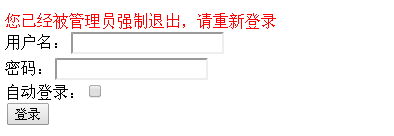




 浙公网安备 33010602011771号
浙公网安备 33010602011771号